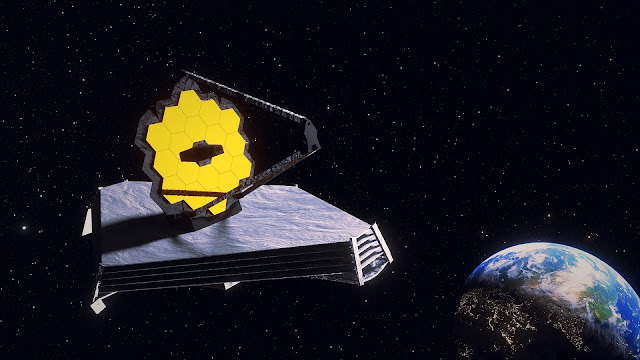The James Webb Space Telescope (JWST)
The James Webb Space Telescope (JWST) is a large, infrared-optimized
space observatory that is set to launch in 2021. It is a collaboration between
NASA, the European Space Agency (ESA), and the Canadian Space Agency (CSA).
This revolutionary instrument is poised to be the successor to the Hubble Space
Telescope, which has been in operation for more than 30 years.
History and Design of the JWST
The idea for the JWST dates back to the 1990s when the scientific community first realized the limitations of the Hubble Space Telescope in observing the early universe. The Hubble is limited by its small size and its sensitivity to visible light. In contrast, the JWST will be optimized for the infrared portion of the spectrum, which will allow it to observe the formation of the first stars and galaxies.
The telescope has four main scientific instruments: the Near Infrared Camera (NIRCam), the Near Infrared Spectrograph (NIRSpec), the Mid-Infrared Instrument (MIRI), and the Fine Guidance Sensor/Near InfraRed Imager and Slitless Spectrograph (FGS/NIRISS). These instruments will enable the JWST to observe a wide range of astronomical phenomena, from the formation of the first stars and galaxies to the study of exoplanet atmospheres.
Science Goals of the JWST
The JWST has several key science goals that it aims to achieve. One of its primary goals is to observe the first galaxies that formed after the Big Bang. By observing these early galaxies, scientists hope to learn more about the processes that led to their formation and evolution. The JWST will also study the formation of stars and planets within our own galaxy, including the processes that lead to the formation of habitable planets.
Another key goal of the JWST is to study the atmospheres of exoplanets. By analyzing the light that passes through an exoplanet's atmosphere as it transits in front of its host star, scientists can learn about the planet's composition, temperature, and other key properties. This information can help us to better understand the conditions necessary for the formation of life in the universe.
Technical Challenges and Risks
The development of the JWST has not been without its challenges and risks. The telescope has experienced numerous delays and cost overruns, with its launch originally scheduled for 2007. In addition, the complexity of the instrument has led to concerns about its reliability and the potential for technical problems during its deployment.
One of the main technical challenges of the JWST is its sun shield, which is designed to protect the telescope from the heat of the sun. The sun shield consists of five layers of a special material that is thinner than a human hair. It is designed to unfurl in space and cover an area the size of a tennis court. The deployment of the sun-shield is a critical aspect of the telescope's mission, and any technical problems during this process could jeopardize the entire mission.
International Collaboration
The James Webb Space Telescope is a major international collaboration between NASA, the European Space Agency (ESA), and the Canadian Space Agency (CSA). Each agency is responsible for different aspects of the mission, with NASA leading the project and providing the telescope's primary mirror, while the ESA is responsible for the telescope's launch and the CSA for one of its scientific instruments.
Launch and Deployment
The JWST is scheduled to launch on October 31, 2021, on an Ariane 5 rocket from Europe's spaceport in French Guiana. After launch, the telescope will spend about a month traveling to its destination at the second Lagrange point (L2), which is about 1.5 million kilometers from Earth. Once it arrives at L2, the telescope will begin a complex deployment sequence that will take several weeks to complete.
During deployment, the telescope's sunshield will be unfurled, and its mirror and scientific instruments will be deployed and tested. This will be a critical phase of the mission, as any technical problems during deployment could jeopardize the telescope's ability to carry out its scientific goals.
Infrared Capabilities
One of the key features of the James Webb Space Telescope is its ability to observe in the infrared portion of the spectrum. Infrared light has longer wavelengths than visible light, which makes it ideal for studying objects that are too faint or too distant to be observed in visible light. The JWST's scientific instruments are specifically designed to take advantage of this capability, allowing it to study everything from the formation of the first galaxies to the atmospheres of exoplanets.
Legacy of the Hubble Space Telescope
The James Webb Space Telescope is often referred to as the successor to
the Hubble Space Telescope, which has been in operation since 1990. While the
two telescopes have some similarities, they are also very different
instruments, with different scientific capabilities and design features. The
Hubble is primarily a visible-light telescope, while the JWST is optimized for
the infrared portion of the spectrum. The two telescopes will work together to
provide a more complete picture of the universe, with the JWST focusing on the
earliest stages of cosmic history and the Hubble continuing to study the
universe in visible light.
Conclusion
In conclusion, the James Webb Space Telescope is a major new instrument
that is poised to revolutionize our understanding of the universe. Despite the
technical challenges and risks associated with its development, the telescope
has the potential to make groundbreaking discoveries in a wide range of
scientific fields. Its launch and deployment in 2021 will be a critical
milestone in the history of astronomy, and it will be exciting to see what
discoveries the telescope will make in the years to come.






0 Comments
If you have any doubt,Plese let me know